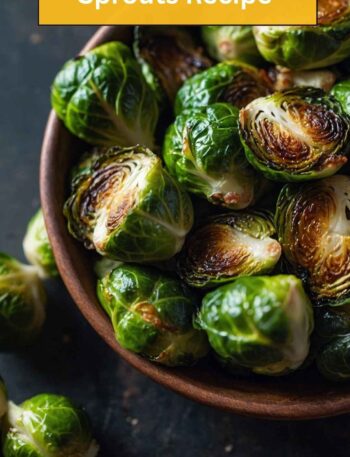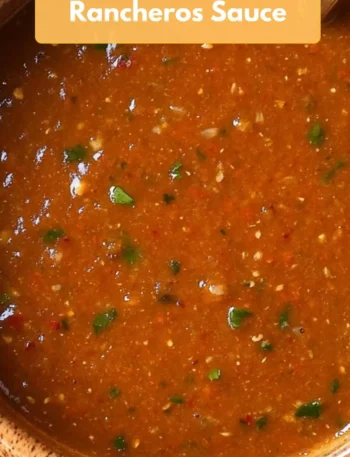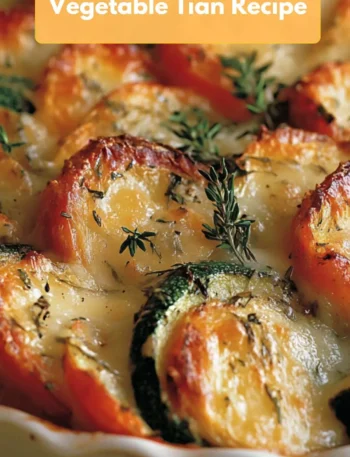Ah, Vegetable Alfredo—when you hear those two words, your taste buds probably start to salivate. Alfredo sauce is a classic in Italian cuisine, traditionally rich and creamy, often paired with fettuccine or other noodles. But what happens when you add vibrant vegetables into the mix? The result is a dish that’s not just comforting but also bursting with life.
Before we dive into the magic of Vegetable Alfredo, let’s consider what goes well with it. A balanced meal can elevate the experience. Here are a few pairings to think about:
- Garlic Bread: A crispy, buttery accompaniment that complements any pasta dish.
- Caesar Salad: Tangy and crisp, this salad cuts through the creaminess of Alfredo.
- Grilled Chicken or Tofu: For added protein, these options work well with the rich sauce.
- Roasted Vegetables: Say, bell peppers, zucchini, or carrots—these add a smoky flavor that enhances the dish.
Now, let’s explore the simple yet delightful world of Vegetable Alfredo.
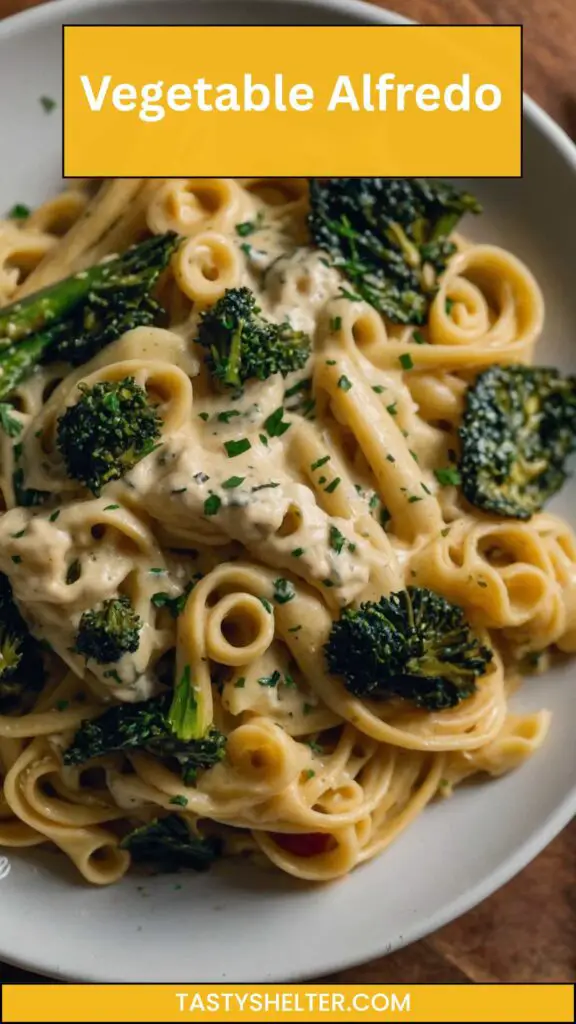
You’ll Also Like These Recipes
- Healthy Homemade Teriyaki Sauce
- Crispy Asian Brussels Sprouts
- Healthy Thousand Island Dressing Recipe
What is Vegetable Alfredo?
At its core, Vegetable Alfredo combines creamy Alfredo sauce—which includes butter, heavy cream, and cheese—with an assortment of fresh vegetables. Shiitake mushrooms, asparagus, and peas often star in this dish. Each ingredient contributes its unique flavor and texture, creating an inviting harmony on your plate. The beauty of this recipe is its flexibility. You can swap in your favorite vegetables according to the season or what’s available in your pantry.
What Does It Taste Like?
Imagine a dish that’s creamy, buttery, and with every bite, a burst of harmony from the fresh vegetables. The richness of the Alfredo sauce melds beautifully with the fresh and slightly earthy flavor of the mushrooms, followed by the crispness of asparagus and the sweet pop of peas. A hint of lemon zest brightens the overall experience, while the Parmigiano-Reggiano adds a savory note that’s hard to resist. It’s comfort food without the guilt.
Why This Recipe Works?
This recipe is a crowd-pleaser for several reasons:
1. Simplicity
You can whip this dish up in about 30 minutes. Whether you’re rushing home from work or hosting a dinner party, this recipe makes it incredibly easy to impress without the stress.
2. Nutritious Balance
By using a variety of vegetables, you’re not just making a tasty dish—you’re packing in vitamins, fiber, and antioxidants. This recipe transitions Alfredo from a heavy, indulgent meal to a more balanced option.
3. Flavor Fusion
The combination of cream, cheese, and fresh veggies creates a flavor explosion. The earthy mushrooms, tender asparagus, and sweet peas dance together in a delicious symphony. Add a splash of white wine, and the depth of flavor increases dramatically.
4. Versatility
Want to switch it up? Change the pasta or the vegetables. Have spinach instead of asparagus? Go for it! Feel like adding some sun-dried tomatoes or olives? That works too. This recipe can adapt to your preferences.
Ingredients for Vegetable Alfredo
Now that we’ve set the stage, let’s talk turkey—or rather, vegetables. Here’s what you’ll need for this dish:
- 1 stick (8 tablespoons) unsalted butter
- 2 cups sliced shiitake mushrooms (about 4 ounces), stems removed
- 1 bunch thin asparagus, trimmed, about 1 pound
- ½ cup frozen peas, thawed
- 1 tablespoon chopped fresh chives
- 1 ½ cups freshly grated Parmigiano-Reggiano cheese
- Finely grated zest of ½ lemon
- 2 cups heavy cream
- 1 teaspoon minced garlic (optional)
- 1 tablespoon white wine (optional)
- One 9-ounce package fresh fettuccine pasta
- Extra-virgin olive oil, for drizzling
- Kosher salt, to taste
- Freshly ground black pepper, to taste
Step by Step Instructions
Step 1: Boil the Pasta
Start by filling a large pot with water and adding a generous pinch of salt. Bring it to a boil. Once boiling, drop in the fresh fettuccine and cook according to package instructions until al dente. This usually takes about 3-5 minutes.
Step 2: Prepare the Vegetables
While the pasta cooks, heat a large skillet over medium heat. Add the butter and let it melt. Once melted, add the sliced shiitake mushrooms. Cook for about 4-5 minutes, stirring occasionally until they’re lightly browned.
Step 3: Add the Asparagus and Peas
Next, toss in the trimmed asparagus. Stir well so that the butter nicely coats the vegetables. After about 3 minutes, add the thawed peas. Season with a pinch of salt and freshly ground black pepper. Cook until everything is tender but still vibrant in color.
Step 4: Create the Sauce
Pour the heavy cream into the skillet with the vegetables. Let it simmer gently for 5 minutes. Stir in the grated Parmigiano-Reggiano cheese until it melts smoothly into the mix. If you’re using garlic and white wine, add them now for an extra layer of flavor.
Step 5: Add the Pasta
Once the pasta is cooked, reserve a bit of the pasta water, then drain it. Add the pasta directly to the skillet with the sauce. Toss everything together until the pasta is well-coated. If the sauce seems too thick, add a splash of reserved pasta water to achieve your desired consistency.
Step 6: Finish with Zest and Chives
Finally, stir in the lemon zest and chopped chives for a fresh finish. Give it a taste and adjust seasoning if needed.
Step 7: Serve Immediately
Dish it out onto plates, drizzling a little extra-virgin olive oil on top. You’re ready to dazzle your guests—or yourself!
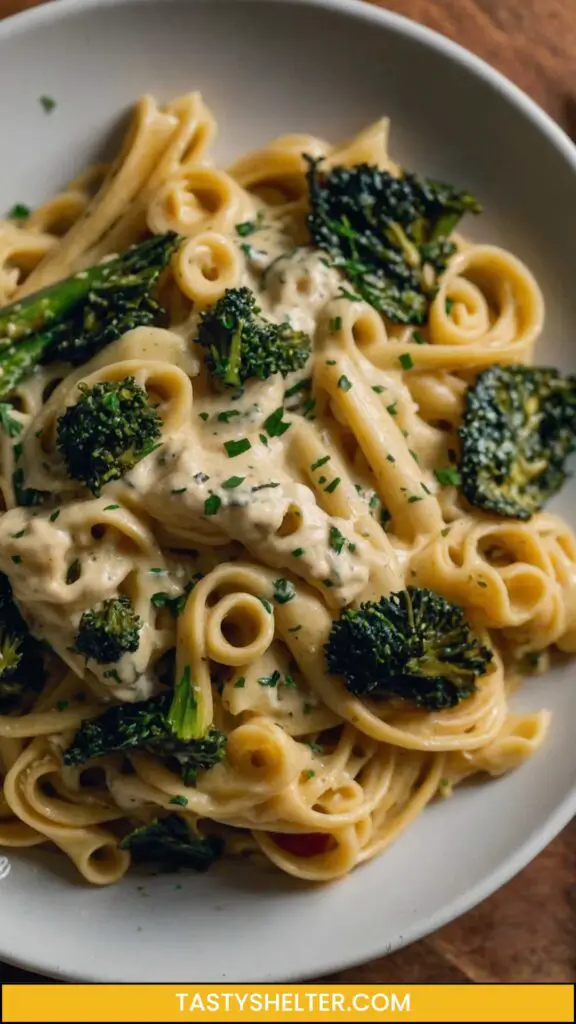
Notes
- Use Fresh Ingredients: Fresh vegetables will yield the best flavor and texture.
- Don’t Overcook: Keep an eye on the vegetables. You want them tender but not mushy.
- Keep Stirring: Stirring is key to evenly distribute the sauce and prevent sticking.
- Variate with Herbs: Fresh basil, oregano, or parsley can add a delightful twist.
- Make it Ahead: You can prepare the sauce ahead of time and simply add the pasta before serving.
Nutrition Information
Each serving of Vegetable Alfredo typically contains roughly:
- Calories: 600-700
- Protein: 20 grams
- Carbohydrates: 60 grams
- Fats: 30 grams
- Fiber: 4 grams
Of course, this can vary based on the exact ingredients used.
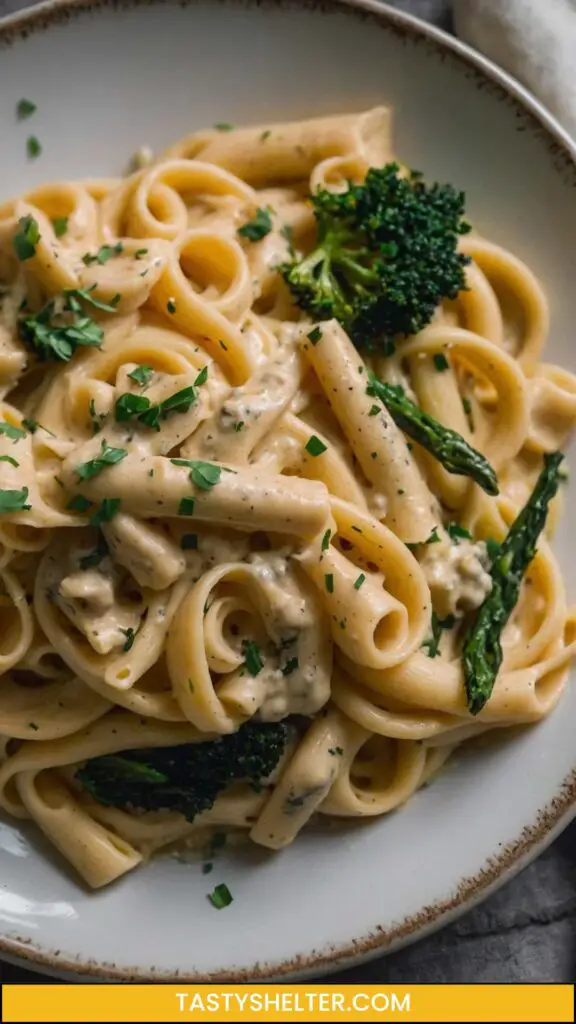
How to Store the Leftovers?
Allow any leftovers to cool completely. Store them in an airtight container in the refrigerator. It’s best to consume them within 3 days. To reheat, place in a skillet on low heat. Add a splash of milk or cream to bring back the creaminess if needed.
Sides for Vegetable Alfredo
If you want to round out your meal, consider these sides:
1. Garlic Bread
Simple and satisfying, warm garlic bread is a classic pairing. Slather it with butter and minced garlic, then bake until golden for that crunchy contrast.
2. Caesar Salad
This classic salad features crispy romaine, crunchy croutons, and a creamy dressing. Its zesty flavors balance well with the richness of the Alfredo sauce.
3. Grilled Veggies
A medley of grilled zucchini, bell peppers, and eggplant makes for a colorful, tasty plate that complements the pasta perfectly. The smokiness of grilled vegetables adds depth.
4. Tomato Basil Bruschetta
Fresh bruschetta topped with ripe tomatoes, basil, and a drizzle of balsamic reduction provides a fresh burst of flavor that harmonizes with the creamy pasta.
What Are Some Alternative Choices to the Ingredients?
Sometimes, you don’t have all the exact ingredients. Here are some handy substitutions:
1. Pasta Choices
If you’re out of fettuccine, feel free to use penne, rigatoni, or any pasta shape you love. It all works!
2. Cheese Alternatives
Don’t have Parmigiano-Reggiano? Grate some Pecorino Romano or even nutritional yeast for a vegan option that still brings that cheesy flavor.
3. Vegetable Varieties
Out of asparagus? Use broccoli, or throw in some spinach or bell peppers instead. Get creative with whatever you have.
4. Cream Substitutes
If you want a lighter option, swap heavy cream for half-and-half. You can even use plant-based cream for a vegan version.
Vegetable Alfredo
Equipment
- Skillet
Ingredients
- 1 stick 8 tablespoons unsalted butter
- 2 cups sliced shiitake mushrooms about 4 ounces, stems removed
- 1 bunch thin asparagus trimmed, about 1 pound
- ½ cup frozen peas thawed
- 1 tablespoon chopped fresh chives
- 1 ½ cups freshly grated Parmigiano-Reggiano cheese
- Finely grated zest of ½ lemon
- 2 cups heavy cream
- 1 teaspoon minced garlic optional
- 1 tablespoon white wine optional
- One 9-ounce package fresh fettuccine pasta
- Extra-virgin olive oil for drizzling
- Kosher salt to taste
- Freshly ground black pepper to taste
Instructions
Step 1: Boil the Pasta
- Start by filling a large pot with water and adding a generous pinch of salt. Bring it to a boil. Once boiling, drop in the fresh fettuccine and cook according to package instructions until al dente. This usually takes about 3-5 minutes.
Step 2: Prepare the Vegetables
- While the pasta cooks, heat a large skillet over medium heat. Add the butter and let it melt. Once melted, add the sliced shiitake mushrooms. Cook for about 4-5 minutes, stirring occasionally until they’re lightly browned.
Step 3: Add the Asparagus and Peas
- Next, toss in the trimmed asparagus. Stir well so that the butter nicely coats the vegetables. After about 3 minutes, add the thawed peas. Season with a pinch of salt and freshly ground black pepper. Cook until everything is tender but still vibrant in color.
Step 4: Create the Sauce
- Pour the heavy cream into the skillet with the vegetables. Let it simmer gently for 5 minutes. Stir in the grated Parmigiano-Reggiano cheese until it melts smoothly into the mix. If you’re using garlic and white wine, add them now for an extra layer of flavor.
Step 5: Add the Pasta
- Once the pasta is cooked, reserve a bit of the pasta water, then drain it. Add the pasta directly to the skillet with the sauce. Toss everything together until the pasta is well-coated. If the sauce seems too thick, add a splash of reserved pasta water to achieve your desired consistency.
Step 6: Finish with Zest and Chives
- Finally, stir in the lemon zest and chopped chives for a fresh finish. Give it a taste and adjust seasoning if needed.
Step 7: Serve Immediately
- Dish it out onto plates, drizzling a little extra-virgin olive oil on top. You’re ready to dazzle your guests—or yourself!
Notes
- Use Fresh Ingredients: Fresh vegetables will yield the best flavor and texture.
- Don’t Overcook: Keep an eye on the vegetables. You want them tender but not mushy.
- Keep Stirring: Stirring is key to evenly distribute the sauce and prevent sticking.
- Variate with Herbs: Fresh basil, oregano, or parsley can add a delightful twist.
- Make it Ahead: You can prepare the sauce ahead of time and simply add the pasta before serving.
Nutrition
Frequently Asked Questions
1. Can I use gluten-free pasta?
Absolutely! Simply substitute regular pasta with your favorite gluten-free variety. The cooking times might vary, so keep an eye on it while cooking.
2. Can I make this recipe vegan?
Yes! Use plant-based butter, vegan cream, and nutritional yeast instead of cheese. The flavors will still be fantastic.
3. How can I add protein to this dish?
Consider adding grilled chicken, shrimp, or tofu for an added protein boost. They’ll blend in beautifully with the vegetables and sauce.
4. Is this dish freezer-friendly?
While the sauce can be frozen, it is best enjoyed fresh. If you do freeze it, separate the pasta and sauce. Reheat gently on the stovetop with a splash of cream.
Conclusion
The joy of cooking Vegetable Alfredo lies in its simplicity and adaptability. Whether you’re cooking for family, friends, or yourself, this dish promises comfort wrapped in fresh, vibrant flavors. You don’t need to be a culinary expert to whip it up; just some quality ingredients and a little love.
Dive headfirst into this dish and savor each bite. Remember, food is all about connection—whether to flavors or to people. As you enjoy your Vegetable Alfredo, take a moment to share it with someone special or enjoy it with a good book. It’s time to transform your kitchen into a cozy Italian trattoria, one plate at a time. Salute!

